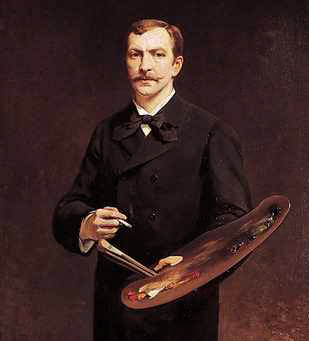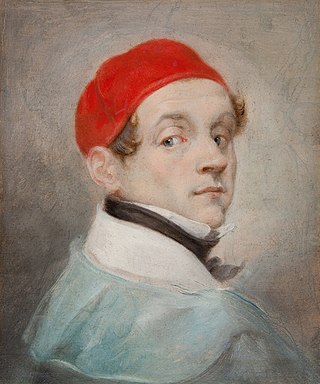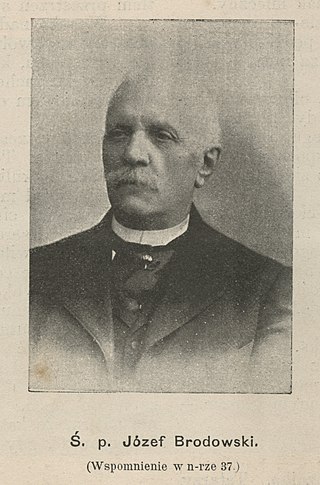This article relies largely or entirely on a single source .(December 2019) |

Tadeusz Brodowski (2 September 1821, Warsaw - 31 March 1848, Paris) was a Polish painter; primarily known for scenes with horses.
This article relies largely or entirely on a single source .(December 2019) |

Tadeusz Brodowski (2 September 1821, Warsaw - 31 March 1848, Paris) was a Polish painter; primarily known for scenes with horses.
He was born into a gentrified family with an artistic tradition. His father was the Classical painter, Antoni Brodowski, and he was the older brother of Józef Brodowski, a prominent painter of battle scenes.
His first painting lessons came from his father. After that, he studied in the workshops of Aleksander Kokular and Antoni Blank. In 1841, he went to Rome. Two years later, after mounting an exhibition in Warsaw, he moved to Paris, where he perfected his techniques with the battle painter, Horace Vernet. His works also show the influence of Aleksander Orłowski.
He died, aged only twenty-six, of unspecified causes; although his death came shortly after the beginning of the French Revolution of 1848.
Most of his known paintings involve horses; primarily in battle scenes and historical events. He also did caricatures and a few Orientalist works.
![]() Media related to Tadeusz Brodowski at Wikimedia Commons
Media related to Tadeusz Brodowski at Wikimedia Commons

Wojciech Horacy Kossak was a Polish painter and member of the celebrated Kossak family of artists and writers. He was the son of painter Juliusz Kossak, and twin brother of freedom fighter Tadeusz Kossak, and the father of two highly talented literary daughters, Maria Pawlikowska-Jasnorzewska and Magdalena Samozwaniec and of a painter son, Jerzy Kossak.

Juliusz Fortunat Kossak was a Polish historical painter and master illustrator who specialized in battle scenes, military portraits and horses. He was the progenitor of an artistic family that spanned four generations, father of painter Wojciech Kossak and grandfather of painter Jerzy Kossak.

Jan Styka was a Polish painter noted for producing large historical, battle-piece, and Christian religious panoramas. He was also illustrator and poet. Known also as a great patriotic speaker - his speeches were printed in 1915 under the French title L'ame de la Pologne.

Franciszek Kostrzewski was a Polish illustrator, cartoonist, caricaturist, comics artist and painter in the Realistic style.

Piotr Michałowski was a Polish painter of the Romantic period, especially known for his many portraits, and oil studies of horses. Broadly educated, he was also a social activist, legal advocate, city administrator and President of the Kraków Agricultural Society. The Sukiennice Museum, a division of the National Museum in Kraków, contains a room that is named after him and devoted to Michałowski's work.

Aleksander Kotsis was a Polish painter. He created landscapes, portraits, and genre scenes in a combination Romantic and Realistic style. Most of his paintings are small. He was born and died in Kraków.

Józef Brodowski, was a Polish painter in the Classical style. He is called The Elder to distinguish him from Józef Brodowski (1828–1900), who was apparently not related.

Stanisław Masłowski was a Polish painter of realistic style, the author of watercolor landscapes.

Tadeusz Ajdukiewicz was a Polish realist painter from around the turn-of-the-century, best known for his battle-scenes, portraits, landscapes and paintings of horses. He was educated in Kraków in the Austrian sector of the Partitioned Poland. He died in the armed struggle for Poland's independence around Kraków during World War I.

Ignacy Aleksander Gierymski was a Polish painter of the late 19th century, the younger brother of Maksymilian Gierymski. He was a representative of Realism as well as an important precursor of Impressionism in Poland.

Antoni Stanisław Brodowski was a Polish painter in the Classical style.

Wojciech Korneli Stattler or Albert Kornel Stattler was a Polish Romantic painter of Swiss aristocratic ancestry, who started training in Vienna and at age 17 went to St. Luke's Academy in Rome. From 1831 he taught as professor at the School of Fine Arts in Kraków. 1850 he returned to Rome. His most famous pupil was Poland's leading painter of historical figures and events, Jan Matejko.

The Gallery of 19th-Century Polish Art at Sukiennice, is a division of the National Museum, Kraków, Poland. The Gallery is housed on the upper floor of the Renaissance Sukiennice Cloth Hall in the center of the Main Market Square in Old Town Kraków.

Rafał Hadziewicz was a Polish painter; primarily of portraits and religious works, and an expert on ancient culture.

Aleksander Lesser was a Polish painter, illustrator, sketch artist, art critic, and amateur researcher of antiquities. Lesser was Jewish, and became one of the first artists to depict scenes from modern Jewish history in Poland. He specialized in Polish historical and contemporary themes, and he was known and respected in artistic and scholarly circles. He was a member of Kraków's Academy of Learning and co-founder of Warsaw's Zachęta, the Society for Encouragement of the Fine Arts.

Jan Antoni Blank was a Polish painter in the Classical style who specialized in portraits and miniatures; many of which are in a style similar to Biedermeier. He often signed his paintings as Jan Antoni Blank-Białecki

Józef Brodowski was a Polish painter. He is referred to as The Younger to distinguish him from Józef Brodowski, who apparently was not related.

Antoni Kozakiewicz was a Polish genre painter in the Realist style.

Maximilian (Maksymilian) Antoni Piotrowski (1813–1875) was a Polish painter and professor at the Academy of Fine Arts in Kaliningrad. Additionally, he was a Polish patriot who took part in the national uprisings of the time.
Józefat Ignacy Łukaszewicz was a Polish-Lithuanian painter.